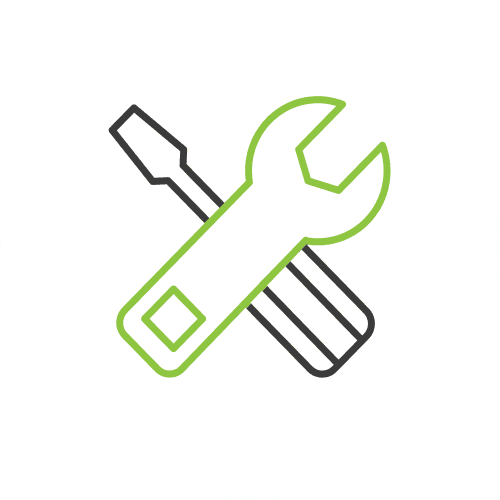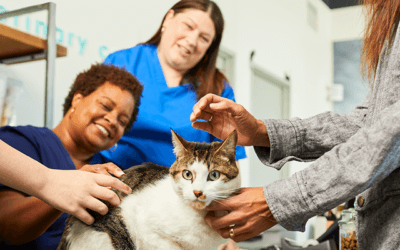Since March, our lives have been turned upside down by the events associated with COVID-19. Of all the extremely stressful and frustrating side effects this experience has had on clinics, one of the most disappointing results is the loss of staff, particularly veterinarians and veterinary technicians. It was difficult enough to find an associate or tech before the pandemic and now many of these incredible, hard-to-find professionals have elected to turn and walk away.
Let’s take a look at why this is happening and what we can do about it.
Why are we losing our veterinarians and techs?
One of the biggest challenges we have faced during this time is the inability to keep up with patient needs and client demand. It seems there are many causes to this.
1: Longer appointments
Appointments now take longer than before due to the extra work from safety regulations. In an effort to not run staff into the ground, most hospitals have extended their original appointment time lengths. There go a few appointments each day right there.
2: More stress-aggravated diseases
Something that truly surprised me (mostly because it had never crossed my mind as one of the million problems to consider) was the increase in stress-based or stress-aggravated disease processes from pets whose home environment suddenly shifted from the norm. This phenomenon occurred not only at my clinic, but at clinics run by my friends and colleagues around the country. I have honestly never seen so many blocked cats in my life!
3: More appointments
While clients were either working from home or laid off, they seemed to notice a lot more issues with their pets that needed to be addressed. A good thing, of course, but that means even more appointments are required each day. Then there was the wonderful pandemic effect of empty shelters as people stuck at home decided it was a good time to adopt a pet. This is great news! But where are we going to put those appointments when we can hardly keep up with our existing clients?
4: Smaller staff
Initially we were operating with a fraction of the staff due to heavy regulation about how many people could be in the facility at the same time. We also tried to rotate in teams just in case anyone became infected, but this led to many staff scheduling difficulties, as well as long, exhausting shifts. Although we have now figured out a functional flow to remain compliant, we are still working with less staff than normal. Here in New York State, we were initially reduced down to urgent care and emergency visits only due to executive order. While I was immediately flooded with fear that clients would stay at home with their sick pets because they were too afraid to leave the house, I was wrong. We were absolutely crammed to the gills with sick pets all day.
5: More disgruntled clients
We all faced an unreal amount of angry and disgruntled clients, many of which were taking out their own, unrelated stress on teams around the country.
When will these challenges end?
 All of this has been going on for about 8+ months now. Let’s be honest, that is a lot to bear for an extended period of time. My staff and local colleagues initially responded with an impressive and inspiring “we got this” attitude and were amazing. They tolerated all these challenges and navigated the extremely unknown and stressful waters, pushing themselves to lengths they didn’t even know they had.
All of this has been going on for about 8+ months now. Let’s be honest, that is a lot to bear for an extended period of time. My staff and local colleagues initially responded with an impressive and inspiring “we got this” attitude and were amazing. They tolerated all these challenges and navigated the extremely unknown and stressful waters, pushing themselves to lengths they didn’t even know they had.
The problem, though, is that it is easier to muster the strength to push through when there is an end in sight. Unfortunately that end still hasn’t come. Many people seem to think that the old way of seeing appointments and practicing veterinary medicine is over and we will remain in this new norm for the foreseeable future (which currently seems true) and will eventually have some type of less regulated environment.
When we sit down (who has time for that?) and look at all the challenges, is it really any wonder that professionals are taking their licenses off the walls and saying forget it?
But wait, there’s more — The challenges of work/life balance
And now we add into this pile of problems the stress of home life. We as veterinary professionals have traditionally not been great at balancing home life and work life (we are getting better though) and many of us may now suddenly be homeschooling as well. People with younger children cannot leave them at home unattended to complete their work. Nor can they take them to preschool or to babysitters or even to grandparents in some cases.
Some or all of this is why we are losing staff, from receptionists to doctors. When a doctor leaves the field due to stress after completing extensive and expensive education while they still have several good practicing years ahead of them, that should indicate the seriousness of the problem.
So what can we do to manage things in such a way that we can make this time more bearable for our doctors and staff and retain every team member that we can?
4 ways to retain veterinary staff even during a pandemic
![]()
1: Allow adjustments and flexibility for family
People must do what is right for them because family needs to come first. That is something we should never forget.
I have worked in several practices over the decades that failed to understand that you can be an excellent and dedicated employee, but still need to step back and handle some family things first. I refer to this as the “practice is priority” culture and I still think it is a terrible idea. This culture teaches your employees that you will take from them all the time they can give to your practice, but you don’t care about their outside life or their family. This is not to say that you must tolerate excessive absences or tardiness due to family issues but just try to be flexible as much as possible.
Perhaps you have a doctor who has younger children that are now staying home and the doctor’s current schedule is causing them great stress to meet the needs of their family and their job. Can you possibly adjust their schedule? Is there a doctor who is not homeschooling who might be willing to switch shifts? Can you allow them to come in late or leave early? Do what you can.
You may end up losing some doctor availability and yes, that is really hard right now because of the already limited appointment slots and the cut it will make into revenue. However, if you aren’t willing to adjust where you can, you may end up losing that doctor entirely if they have to choose family and then you’ll be in a far worse spot. We all know how hard it was to find an associate…pre-COVID.
2: Set the tone with client communication
 If you read one of my previous blog posts, you’ll know how I feel about abusive clients. Much like preventative medicine, the best thing you can do to prevent unwanted behavior is focus on crystal clear communication to your clientele. They need to know what to expect and what is expected of them before they walk in the door.
If you read one of my previous blog posts, you’ll know how I feel about abusive clients. Much like preventative medicine, the best thing you can do to prevent unwanted behavior is focus on crystal clear communication to your clientele. They need to know what to expect and what is expected of them before they walk in the door.
Only one client inside wearing a mask? Strict curbside? Whatever it is, make sure clients know ahead of time. Discuss it on the phone, put it in an email, put it on your website, etc. List the actual process about how curbside will work, down to the detail. Go ahead and include right there that you are doing the best you can to provide great customer care while under heavy regulation and that you are asking for patience and respect during these times. Blast them with information about what to expect so there are no surprises. Be firm about your requirements but kind and professional.
Even the busiest days are so much easier when they aren’t filled with angry clients. Confrontation can be avoided and seriously decreased with good communication. Failed or lack of communication is (at least in my opinion) the cause of most major problems. If a client can’t come inside, they need to know that long before their appointment when your staff get stuck handling that client. Sure, you are still going to hear some of these things even with the best communication but it will be significantly less.
Still, from time to time you may need to step in and stand up to defend your doctors and teams when they need it. I do expect and train all of my staff to have a level of ability to handle confrontation because that comes with the field and I do think that most of them are quite decent at it. But it can take years to develop the skills necessary for successful conflict resolution. Keep your ears open and step in as needed.
“Your team must know that you have their backs, now more than ever.”
3: Check in with veterinary staff members regularly
Don’t forget to check in with your team members and by this, I mean all of them. What are they feeling? How are they doing? What do they need to be more effective?
I believe in an environment where employees are trained, empowered, and require minimal supervision. However, supervision is not the same as support. During the pandemic, this is a time where staff members will need more encouragement and support than ever before. One on ones are crucial. Even if your team says they are fine and they don’t need anything, they will still appreciate you checking in. It’s a great way to show that you really care.
In a time where it can be really challenging to have meetings, figure out how to make it happen. Take this time to listen to your staff and support them. Ask them about the current issues they and the practice are struggling with and see if they have any ideas on how things can run more smoothly. I am a strong advocate for teams being very involved in protocol and policy creation and adjustment. After all, they are the ones doing the protocols all day long. Work through the challenges together. This also helps team members feel empowered because it reminds them that their input and opinions are valued.
4: Provide team members with resources and tools
In the none-to-very-limited time you have with your staff, make sure you are providing what you can resource-wise.
I would highly, highly recommend some compassion fatigue training. If there was ever a time to be burned out, this is it. I can honestly say that I reached a severe level of burnout a few months ago, even with my experience and training. There was so much negativity happening in the world and it had leaked into my clinic despite my attempts to fight it back out the door. I felt like the culture and all the hard work I had done was crumbling before my eyes as I was trying to super glue it back together. In a word, depressing.
Anyone who personally or professionally knows me would likely describe me as confident and capable of managing any stressful situation without showing a shred of distress or panic. However, after about five months of being beat down with all of this, there were several shifts that I hid in my office and cried as I worked. I questioned my own effectiveness and ability to continue to succeed in management. I was overwhelmed with problems and it was difficult.
I enrolled myself in training for compassion fatigue certification and felt like I did a 180 in regards to stress after a few education sessions. I enrolled myself for certification so that I could take care of myself and pass on what I learned to my staff. I wish I had started this sooner. There are several certified people and companies you can hire to work with your staff. This kind of training helps you remember that not all variables are within your control plus how to work with the ones that are and deal with the ones that are not. I understand that it is truly hard to squeeze in meetings right now but I implore you to take the time and spend the money to do this. I hired a professional for an hour of training, bought all the staff $25 gift cards for food, and paid them as we did a Zoom meeting together after work. It was worth every single cent.
There are also other mental health resources you may consider posting. A wonderful non-profit has been created called The Emotional PPE Project. This group features licensed therapists and psychiatrists volunteering to provide free help for essential healthcare workers who are overwhelmed with the work and emotional baggage put on them by the pandemic. They require no insurance, have no fee, and are available by phone, text, and email. Tell your staff about it, then post the information for them.
Summary — It will take everything you’ve got
All in all, these suggestions seem like simple things we can do to retain our staff and doctors during COVID-19. They are simple; the problem then is the time and workload required to implement them. THAT’S hard. Also, you might do everything you possibly could and still end up losing staff or doctors. But why not at least try and make your work environment a good place to be, despite all of the extreme stress?
Make the time and the effort to do it and if someone still decides to walk away, you know that you’ve done all you can for them and for the people that are still there. These are difficult times with no potential end in sight. For a while, it looks like we will still be adjusting as we go. Be sure to make the needs of the doctors and staff part of that.
Good luck to you friends, and remember that we have to support each other and reach out when we need help or a friend to lean on. Keep your eyes on the horizon for better times to make the best of what we are experiencing right now.



